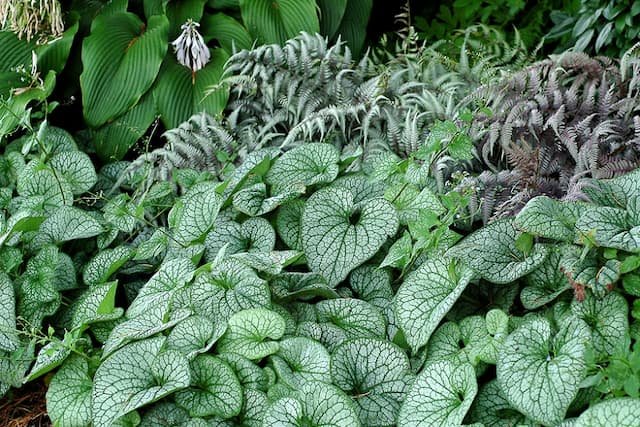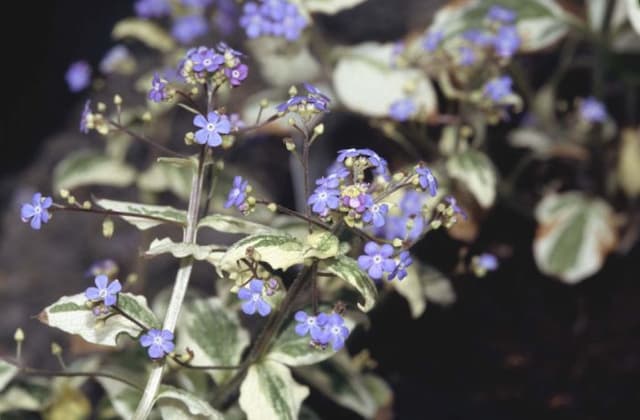Siberian Bugloss Brunnera macrophylla 'Betty Bowring'

ABOUT
Brunnera macrophylla 'Betty Bowring', also commonly known as Siberian bugloss, is a plant noted for its delicate appearance and shade-loving nature. The foliage of 'Betty Bowring' is heart-shaped with a rich, solid green hue that provides a fantastic backdrop for its blooms. The leaves are moderately textured, which adds a lush density to the plant's overall look. During the flowering season, ‘Betty Bowring’ stands out with its airy clusters of small, pure white flowers that resemble forget-me-nots. These blossoms are held above the foliage on slender stems, creating a dappled effect that is quite enchanting. The flowers are abundant and contribute a frothy, light feel to the garden during bloom. The aesthetic appeal of 'Betty Bowring' makes it a favorite for woodland gardens or shaded borders, where its contrasting green leaves and bright white flowers can brighten low-light areas. Its charming growth habit and cool, tranquil color palette enhance its surroundings without overpowering other plants. Overall, 'Betty Bowring' offers a serene and elegant presentation, establishing it as a prized specimen for gardeners who value subtle beauty in their plant choices.
About this plant
 Names
NamesFamily
Boraginaceae
Synonyms
Siberian Bugloss, False Forget-Me-Not, Heartleaf Brunnera, Perennial Forget-Me-Not
Common names
Anchusa myosotidiflora, Brunnera myosotidiflora.
 Toxicity
ToxicityTo humans
Siberian bugloss is not commonly known to be toxic to humans. There is limited information about its toxicity, but in general, it is not considered a poisonous plant. However, as with many plants, it is still advisable to avoid ingesting any part of it as it may cause discomfort or an allergic reaction in some individuals.
To pets
Siberian bugloss is also not widely recognized as toxic to pets. Similar to its effects on humans, it is not acknowledged as a poisonous plant, and there is limited data regarding its toxicity to animals. Nonetheless, it is always prudent to prevent pets from ingesting plants, as they may cause gastrointestinal upset or an allergic reaction in sensitive pets.
 Characteristics
CharacteristicsLife cycle
Perennials
Foliage type
Deciduous
Color of leaves
Green
Flower color
White
Height
1 feet 6 inches (45.72 cm)
Spread
1 feet 6 inches (45.72 cm)
Plant type
Herb
Hardiness zones
3
Native area
Caucasus
Benefits
 General Benefits
General Benefits- Easy to Grow: Brunnera 'Betty Bowring' thrives in shade gardens with minimal maintenance.
- Shade Tolerance: It is an excellent plant for shaded areas where other plants may struggle to grow.
- Attractive Foliage: Heart-shaped leaves provide a lush, green backdrop and are appealing throughout the growing season.
- Spring Blooms: Produces delicate white flowers in the spring, adding seasonal interest to the garden.
- Drought Resistance: Once established, it can tolerate periods of dryness, making it suitable for a variety of landscapes.
- Pest Resistance: Generally resistant to pests, reducing the need for chemical treatments.
- Non-Invasive: Forms clumps without aggressively spreading, making it an ideal choice for controlled garden designs.
- Companion Planting: Pairs well with other shade-loving plants like hostas and ferns to create a diverse understory.
- Deer Resistance: Less likely to be eaten by deer, which can be beneficial in areas with high deer populations.
- Seasonal Interest: Provides visual interest during early to mid-spring when many other plants have not yet begun to grow or bloom.
 Medical Properties
Medical PropertiesThis plant is not used for medical purposes.
 Air-purifying Qualities
Air-purifying QualitiesThis plant is not specifically known for air purifying qualities.
 Other Uses
Other Uses- Brunnera macrophylla 'Betty Bowring', also known as Siberian bugloss, can be used in floral arrangements due to its attractive foliage which holds up well and adds texture to bouquets.
- In a classroom setting, Siberian bugloss can be used to teach biological concepts such as leaf morphology and plant reproduction since the heart-shaped leaves and small, detailed flowers provide useful features for educational purposes.
- As an artistic subject, the intricate patterns and silvery variegation on the leaves of 'Betty Bowring' make it an interesting choice for botanical illustration or garden photography.
- In garden design, Siberian bugloss is valuable for creating contrasting textures, especially when planted alongside plants with large, bold leaves.
- This plant can be used to cover the bases of larger plants or trees, providing a living mulch that enhances soil moisture retention and adds aesthetic appeal.
- The leaves of Siberian bugloss can serve as a natural dye source, although not commonly used, for fabrics and materials, producing subtle green hues.
- For wildlife gardens, 'Betty Bowring' provides early foraging for bees and other beneficial insects, which are attracted to its small but abundant flowers.
- Garden hobbyists can use Siberian bugloss in terrariums or fairy gardens, due to its miniature landscape-like appearance and tolerance of shade.
- Some gardeners might find creative use for the dried seed heads of Siberian bugloss in homemade potpourri mixes, adding a natural, rustic touch to home décor.
- During the winter season, the semi-evergreen foliage of Siberian bugloss provides visual interest in dormant gardens, maintaining a hint of color in the landscape.
Interesting Facts
 Feng Shui
Feng ShuiThe Brunnera is not used in Feng Shui practice.
 Plant Symbolism
Plant Symbolism- Perseverance: The plant, commonly known as Siberian bugloss, is known for its hardiness and ability to thrive in shade, symbolizing the ability to persevere through challenging conditions.
- Transformation: With its foliage that changes color throughout the seasons, Siberian bugloss represents transformation and adaptability.
- Memory: Its heart-shaped leaves can be seen as symbols of memories and the past, often used in gardens as a reminder of loved ones.
- Hope: The delicate blue flowers that emerge in spring can symbolize hope and the promise of new beginnings.
 Water
WaterSiberian bugloss requires even moisture, especially in hot summer months, making it important to check the soil moisture regularly. Generally, it should be watered once or twice a week, depending on the climate and weather conditions. Deep watering helps to establish a strong root system, so apply approximately 1 gallon of water per plant during each watering session, ensuring it reaches the roots without waterlogging the soil. During the winter, when the plant is dormant, reduce watering but do not let the soil become completely dry. It is best to water in the morning to allow any excess moisture on the leaves to evaporate during the day, which helps prevent fungal diseases.
 Light
LightSiberian bugloss prefers partial shade to full shade, thriving best where it can avoid the intense heat of direct afternoon sunlight. A spot under dappled sunlight, such as underneath a tree canopy or on the north or east side of a building, is often ideal. Protecting the plant from harsh afternoon sun helps to keep the foliage vibrant and prevents scorching.
 Temperature
TemperatureThe ideal growth temperature for Siberian bugloss ranges within 60°F to 70°F. It is a hardy plant that can withstand temperatures down to about -20°F in winter and can survive up to about 80°F in summer. Sudden temperature fluctuations should be avoided, as consistent conditions promote healthier growth.
 Pruning
PruningSiberian bugloss does not require regular pruning but tidying up spent leaves and flower stalks can encourage new growth and improve the plant's appearance. It's best to prune in early spring or after the plant has finished flowering. Lightly cut back any dead or damaged foliage to maintain the shape and health of the plant. Annual pruning is usually enough to keep Siberian bugloss looking its best.
 Cleaning
CleaningAs needed
 Soil
SoilFor Siberian bugloss 'Betty Bowring', the best soil mix is well-draining, rich in organic matter, with a pH between 5.5 and 7.5. Amend garden soil with compost or peat moss to improve fertility and structure.
 Repotting
RepottingSiberian bugloss 'Betty Bowring' rarely needs repotting; it's typically grown as a perennial in the garden, not in containers, thus does not require frequent repotting.
 Humidity & Misting
Humidity & MistingSiberian bugloss 'Betty Bowring' thrives in average humidity conditions typical of outdoor environments; it does not have specific indoor humidity requirements.
 Suitable locations
Suitable locationsIndoor
Place in well-lit area, keep soil moist, not wet.
Outdoor
Plant in partial shade, enrich soil with organic matter.
Hardiness zone
3-8 USDA
 Life cycle
Life cycleSiberian bugloss 'Betty Bowring' begins its life cycle as a seed, which, once sown, germinates in warm, moist soil, typically in spring. The seedling stage follows germination, where the plant's first leaves, or cotyledons, emerge, and true leaves develop as it establishes a root system. As a perennial, it enters a vegetative stage where foliage expands, and the plant forms a clump with heart-shaped, silver-patterned leaves. During early to mid-spring, it reaches the flowering stage, presenting clusters of small, delicate white flowers that attract pollinators. After flowering, it sets seed which can be dispersed by wind or wildlife, thereby completing the reproductive stage. In the fall, the plant begins to die back, entering a period of dormancy through the winter, conserving energy to begin the cycle anew the following spring.
 Propogation
PropogationPropogation time
Spring to early summer
Propogation: The popular method for propagating Brunnera macrophylla 'Betty Bowring', commonly known as Siberian bugloss or false forget-me-not, involves division. The most suitable time to divide the plants is in the spring, as new growth is starting, or in the fall, after the flowering period is over and the plant has begun to go dormant. To propagate via division, carefully lift the clump of the plant from the ground with a spade or fork and gently separate the crown into smaller sections, each with a portion of the root system intact. Replant these divisions immediately at the same depth they were originally growing, spacing them about 12 to 18 inches (approximately 30 to 45 centimeters) apart to give them ample room to develop. Keep the transplanted divisions well-watered to help establish them in their new locations.









